|
|
|
|
A MULTI-OBJECTIVE OPTIMIZATION OF A SUSTAINABLE SUPPLY CHAIN NETWORK CONSIDERING MULTI-PRODUCT AND MULTI-ITEM USING Ɛ-LEXICOGRAPHIC PROCEDURE
M. S. Al-Ashhab 1, 2![]()
![]() , Abdullah
Al-Otaibi 1
, Abdullah
Al-Otaibi 1![]()
![]()
1 Department of Mechanical Engineering, College of Engineering and Islamic Architecture, Umm Al-Qura University, Makkah 24211, Saudi Arabia
2 Design & Production
Engineering Department, Faculty of Engineering, Ain-Shams University, Cairo
11511, Egypt
|
|
ABSTRACT |
||
|
In this paper,
a mathematical model of multi-objective, multi-item, multi-product, and
multi-period mathematical model has been developed in which several
objectives; profit, total cost, and overall customer service level (OCSL)
have been optimized using the Ɛ-lexicographic procedure. The potential
network of supply chain may include two suppliers, one factory, and two
retailers. The model considered the network design in addition to the
production, inventory, and transportation planning in multi-periods. This model
has been formulated using mixed-integer linear programming and solved by
Xpress IVE. The behavior of the model has been verified by solving two
scenarios of different demand patterns. The results verify the ability of the
developed model to assist supply chain managers to manage their networks more
efficiently and effectively. |
|||
|
Received 04 April 2022 Accepted 09 May 2022 Published 25 May 2022 Corresponding Author M. S.
Al-Ashhab, DOI 10.29121/ijetmr.v9.i5.2022.1162 Funding: This research
received no specific grant from any funding agency in the public, commercial,
or not-for-profit sectors. Copyright: © 2022 The
Author(s). This work is licensed under a Creative Commons
Attribution 4.0 International License. With the
license CC-BY, authors retain the copyright, allowing anyone to download,
reuse, re-print, modify, distribute, and/or copy their contribution. The work
must be properly attributed to its author.
|
|||
|
Keywords: Supply Chain,
Multi-Objective, Multi-Item, Multi-Product, MILP, Xpress IVE |
|||
1. INTRODUCTION
According to Kotler and Keller (Kotler & Keller, 2016), Supply Chain Management (SCM) is a process or a conduit that runs from raw materials passing by components to the final buyer at the end of process. Siahaya Rombe and Hadi (2022) defined SCM as the integration of competent business sources however inside or outside the organization by which a competitive supply system is achieved that focuses on synchronizing product and information flows for providing high customer value as a target.
Top management of all companies with their different departments has earily recognized the strategic importance of SCM Axsäter (2015). Moreover, the companies have viewed the primary characteristics of SCM as a whole, and adopted a strategic orientation with joint efforts, that focus on the customer Mentzer et al. (2001).
An effective inventory policy may be difficult for the complexity of today's supply chains, as well as the high level of interaction between all their nodes, Ganeshan (1999). In fact, the inventory is spread over multiple storage sites within the same system, demanding researchers to consider integrated techniques and modeling the system as a multiechel on inventory system Vrat (2014).
A study by Morash Morash (2001) linked between supply chain (SC) strategy, its capabilities, and firm performance. The study concluded that the relationship between the three factors was extremely important.
The Operational capabilities are divided into three categories: structural, logistic, and technological Hadi and Parubak (2016). In previous research, marketing and SC operational capacity have been demonstrated to have a substantial impact on business performance Mangun et al. (2021), Muslimin et al. (2017), Riswanto (2021). In previous literature numerous indicators advocated for monitoring the success of SCM systems and incorporating organizations Folan and Browne (2005).
There are various indicators have been advocated for monitoring the success of SCM systems in the literature and incorporation of organizations Gunasekaran and Kobu (2007). According to other researchers supply chains, lack accurate Key Performance Indicators (KPIs) for comparison, benchmarking, and decision-making Aramyan et al. (2007).
Chandra and Fisher Yan et al. (2003) attempted to solve the problem of coordinating production and distribution functions in a single plant, with multi-commodity, and multi-period manufacturing setting, where products are manufactured and held in the plant until they are transported to clients through a fleet of trucks. Chang and Park Jang et al. (2002) also overviewed the difficulty of designing a multi-product in a single-period supply network.
In another aspect, Yan Yu, and Cheng Yan et al. (2003) suggested a strategic production-distribution model that created various items in a single time including multiple suppliers, manufacturers, distribution centres, and customers. Altiparmak, Gen, Lin, and Paksoy Altiparmak et al. (2006) also developed a mixed-integer nonlinear model for a multi-objective supply chain network (SCN) created for a single product of a plastic company. In an attempt to solve the challenge, a solution technique based on genetic algorithms has been created. According to Al-Ashhab et al. (2016) the configuration and performance of the SCM were shown to be influenced by the associated objectives. According to their findings, cost minimization does not always imply benefit maximization, however, it was determined to directly maximize profit in this report considering costs in the restrictions.
Alashhab et al. Mlybari (2020) have developed a model for complete green single-item SC planning optimization to reduce SC environmental and economic impacts. On other view, Wang et al. (2011), proposed a multi-objective single-item single-period optimization model that included the environmental investment decision, as strategic supply network planning process. E-constraint technique was employed by some scholars to solve multi-objective optimization problems, by reducing the multi-objective issue into a single objective one and the other objectives treated as constraints. A multi-objective MILP model was provided by Guillén et al. (2005) for SC design problem, considering net present value, demand satisfaction, and financial risk as primary objectives.
Table 1
|
Table 1 Summary of relevant research |
|||||||||
|
Author |
Year |
Multi-suppliers |
Multi-items |
Multi-products |
Multi-periods |
Multi-customers |
objective |
|
|
|
|
|
|
|
|
|
|
profit |
total cost |
OCSL |
|
Franca et al. (2010) |
2010 |
* |
|
|
* |
* |
* |
|
* |
|
Al-e-hashem and Rekik (2014) |
2014 |
* |
|
* |
* |
* |
|
* |
|
|
Pasandideh et al. (2015) |
2015 |
|
|
* |
* |
* |
* |
* |
|
|
Jindal et al. (2015) |
2015 |
* |
* |
* |
* |
|
* |
|
|
|
Al-Ashhab et al. (2016) |
2016 |
* |
|
* |
* |
* |
* |
|
* |
|
Al-Ashhab et al. (2016) |
2016 |
|
|
* |
* |
* |
* |
* |
* |
|
Al-Ashhab et al. (2017) |
2017 |
* |
|
* |
* |
* |
* |
* |
* |
|
Al-Ashhab and Fadag (2018) |
2018 |
* |
|
* |
* |
* |
* |
|
|
|
Alashhab and Mlybari (2021) |
2021 |
* |
* |
* |
* |
* |
* |
|
|
|
Al-Ashhab and Alanazi (2022) |
2022 |
* |
|
|
* |
* |
* |
|
|
|
Al-Ashhab and Alanazi (2022) |
2022 |
* |
* |
* |
* |
* |
* |
|
|
|
Current study |
2022 |
* |
* |
* |
* |
* |
* |
* |
* |
Table 1 shows an overview of some relevant research characteristics. Alashhab and Mlybari (2021), developed a model for multi-item SC design and planning. They have created a multi-item, multi-product, and multi-period mathematical model to maximize profit by optimizing supply, manufacturing, distribution, and inventory planning for a SC with two suppliers, one factory, and two retailers. In this proposed model, Xpress IVE was used to solve the issue, using Mixed Integer Linear Programming. Figure 1 shows the proposed SCN.
Figure 1

|
Figure
1 SCN |
2. MODEL FORMULATION
The model involves the following sets, parameters, and variables:
Sets:
P: Set of products, mentioned by (p)
I: Set of items, mentioned by (i)
S: Set of prospective suppliers, mentioned by (s)
C: Set of prospective retailers, mentioned by (c)
T: Set of prospective, mentioned by (t)
Parameters:
Ff: the fixed cost in period (t)
DEMcpt: demand for retailer (c) of product (p) in period (t) (unit/ period)
REQip: Required amount of item (i) for product (p) (unit)
IIFp: the initial inventory of product (p) (unit)
FIFp: the final inventory of product (p) (unit)
Pct: the unit price of product (p) at retailer (c) in period (t) ($)
Wp: the weight of product (p) (kg)
Wi: the weight of items (i) (kg)
MHp: manufacturing hours for product (p) (hour)
Dsf: the linear distance between the supplier and the facility (km)
Dfc: the linear distance between the facility and the retailer (c) (km);
CAPsit: the capacity of supplier s for item (i) in period (t) (kg)
CAPHFt: Manufacturing capacity of the facility in period (t) (hour)
CAPMft: storage capacity for raw material of the facility in period (t)(kg)
CAPFSFt: Capacity of the storage facility in period (t) (kg)
MATCostsit: material cost per unit of item (i) supplied by supplier s in period (t) ($/kg)
MCft: manufacturing cost per hour for the facility in period (t) ($/hour)
NUCCf: non-utilized manufacturing capacity cost per hour of the facility ($/hour)
SCPUp: back-ordering cost per unit per period ($/unit/period)
HC: holding cost per unit weight per period in the facility store ($/kg/period)
Bsi: the batch size of the item (i) transported from the supplier to the factory (unit)
Bfp: batch size transported from the facility for product (p) to retailer (unit)
Tc: transport cost of the transport mode per kilometer in period (t) ($/km)
Variables:
Ls: If a supplier (s) is contracted, the binary variable is 1; otherwise, it will be 0.
Lsf: If a transportation link between supplier (s) and the factory is activated, a binary variable equal to 1 will be set.
Lfc: If a transportation link is activated between the factory and customer (c), the binary variable equals 1.
Qsfit: number of batches of item (i) transported from supplier (s) to the facility in period (t)
Qfcpt: number of batches of product (p) transported from the facility to retailer (c) in period (t)
Iffpt: number of batches transported from the facility to its store for product (p) in period (t)
Ifcpt: number of batches transported from store of the facility to retailer (c) for product (p) in period (t)
Rfpt: facility store a residual inventory of product (p) in period (t)
CSLc: Customer service level of customer (c)
M: is a big number
2.1. OBJECTIVE FUNCTIONS
The objectives of this proposed model are to maximize profits, minimize total cost, and maximize OCSL. Equation 1, computes the profit by deducting the whole cost from the total revenue,
2.1.1. OVERALL CUSTOMER SERVICE LEVEL (OCSL)
Equation 2, computes the OCSL by summing all customers' customer service levels, as computed by.
2.1.2. TOTAL COST
Equation 3 shows the total cost including all fixed, material, manufacturing, and non-utilized capacity costs, as well as shortages, transportation, and inventory holding costs.
The material costs include all materials given to the factory by all suppliers, as well as the costs of the original inventory materials deducting the costs of the materials utilized to construct the final inventory that will be used after this planning time.
Production costs include manufacturing costs distributed to all retailers with the manufacturing costs of the initial inventory deducting used manufacturing costs of the final inventory after this planning time.
The cost of non-utilized capacity in facility is calculated by multiplying the depreciation per hour of machines during non-utilized time by the non-utilized capacity hours.
The shortage cost is determined by multiplying the shortage quantities of each product in all periods for all retailers by the shortage cost per unit for each period.
Transportation costs are also determined by multiplying the distance travelled by the transportation cost per unit of distance, for all shipments of all transportation modes in all periods for transporting raw materials from suppliers and finished goods to retailers.
Inventory costs, with exception of last period are calculated using the weights of residual product inventory at the end of each period and holding the initial inventory.
2.2. CONSTRAINTS
2.2.1. BALANCE CONSTRAINTS
![]() Equation 5
Equation 5
![]() Equation 6
Equation 6
![]() Equation 7
Equation 7
![]() Equation
8
Equation
8
![]() Equation
9
Equation
9
Constraint Equation 4 to Equation 10 ensures the flow balancing of materials and products in the model.
2.2.2. CAPACITY CONSTRAINTS
Equation 11 ensures that a supplier total flow to the facility does not exceed the capacity of this supplier at each period.
Equation 12 ensures that the total amount of material flowing into the facility from all sources does not exceed the facility's material capacity at each period.
Equation 13 ensures that total number of manufacturing hours for all manufactured and delivered products at the facility to each client and period do not exceed the manufacturing capacity hours.
Equation 14 ensures that the residual inventory, during each period, does not exceed its capacity.
3. MODEL VERIFICATION
The effectiveness of model is clearly displayed in the following example.
3.1. VERIFICATION EXAMPLE INPUTS
In order to verify the model, two scenarios have been created. Table 2 tabulates the demands of each retailer of products over 6 periods for all scenarios.
Table 3 presents the weights of demands for each retailer of products over 6 periods for all scenarios. And Table 4 shows the demand for items needed to fulfil the demand for products. Finally, the list of other parameters and their respective values is given in Table 5.
Table 2
|
Table 2 Demand of retailers of products over 6 periods for all scenarios |
||||||
|
Period |
1 |
2 |
3 |
4 |
5 |
6 |
|
Scenario
1 |
500 |
1,000 |
3,000 |
2,500 |
2,000 |
1,500 |
|
Scenario
2 |
6000 |
4,000 |
4,000 |
500 |
500 |
500 |
Table 3
|
Table 3 Demand weight for all retailers of products over 6 periods for all
scenarios |
|||||||
|
Scenario |
Period |
1 |
2 |
3 |
4 |
5 |
6 |
|
Scenario
1 |
Product
1 |
1500 |
3,000 |
9,000 |
7,500 |
6,000 |
4,500 |
|
Product
2 |
2000 |
4,000 |
12,000 |
10,000 |
8,000 |
6,000 |
|
|
Scenario
2 |
Product
1 |
18000 |
12,000 |
12,000 |
1,500 |
1,500 |
1,500 |
|
Product
2 |
24000 |
16,000 |
16,000 |
2,000 |
2,000 |
2,000 |
|
Table 4
|
Table 4 Demand of items for all retailers of products over 6 periods for all
scenarios |
|||||||
|
Period |
1 |
2 |
3 |
4 |
5 |
6 |
|
|
Scenario
1 |
Item
1 |
3000 |
6000 |
18000 |
15000 |
12000 |
9000 |
|
Item
2 |
4000 |
8000 |
24000 |
20000 |
16000 |
12000 |
|
|
Total
Demand |
7000 |
14000 |
42000 |
35000 |
28000 |
21000 |
|
|
Scenario
2 |
Item
1 |
36000 |
24000 |
24000 |
3000 |
3000 |
3000 |
|
Item
2 |
48000 |
32000 |
32000 |
4000 |
4000 |
4000 |
|
|
Total
Demand |
84000 |
56000 |
56000 |
7000 |
7000 |
7000 |
|
Table 5
|
Table 5 List of input parameters and their respective values |
|||||||
|
No. |
Input parameter |
Value |
Unit |
No.2 |
Input parameter3 |
Value4 |
Unit5 |
|
1 |
S
and C |
2 |
-- |
15 |
MCft |
1 |
$/hr. |
|
2 |
P
and I |
2 |
-- |
16 |
MHp |
1,
2 |
hrs. |
|
3 |
IIfp |
0 |
Unit |
17 |
MCft |
10 |
$/hr. |
|
4 |
FIfp |
0 |
Unit |
18 |
NUCCf |
1 |
$/hr. |
|
5 |
Pct |
110,
220 |
$/Unit |
19 |
SCPUp |
5 |
$/period |
|
6 |
WP
1,2 |
3,
4 |
Kg |
20 |
HC |
0.75 |
$/kg.
period |
|
7 |
MH
1,2 |
1,
2 |
Hrs |
21 |
Bsi |
1,
1 |
Unit |
|
8 |
REQip |
1,
2, 2, 2 |
Kg.
/Unit |
22 |
Bfp |
1,
1 |
Unit |
|
9 |
CAPHft |
30,000 |
Hrs |
23 |
TCt |
0.05 |
$ |
|
10 |
CAPMft |
50,000 |
Kg |
24 |
Ff |
50,000 |
$ |
|
11 |
CAPFSft |
10,000 |
Kg |
25 |
Bf |
1 |
unit |
|
12 |
MATCit |
1,
1, 1, 1 |
$/kg |
26 |
Dsf |
55.8,
40.4 |
Km |
|
13 |
CAPs1 |
9,000 |
Kg |
27 |
Dfc |
14.8,
22.4 |
Km |
|
14 |
CAPs2 |
9,000 |
Kg |
28 |
Wi |
1 |
Kg |
3.2. VERIFICATION EXAMPLES, RESULTS AND DISCUSSION
The following software and hardware are used to solve this model; Xpress IVE software on an Intel(R) Core (TM) i5-10210U CPU @ 1.60 GHz 2.10GHz (8 GB of RAM).
According to first scenario, the optimal network is shown in Figure 2, The demand was increasing and then descending. It is noticed also in the first and second periods, Figure 3, Figure 4 and Figure 5 that demand, and storage were fulfilled. The demand of third period was achieved from the actual production and residual storage. There was a shortage in the fourth period because item 2, Figure 5 was reached was at its highest possible capacity. In the fifth period, the previous shortage was recently compensated, finally the request was fulfilled.
Figure 2

|
Figure
2 The optimal network of the
first scenario |
Figure 3

|
Figure
3 Distribution by weights of the
first scenario |
Figure 4

|
Figure
4 Distribution weight of item 1
of the first scenario |
Figure 5

|
Figure
5 Distribution weight of item 2
of the first scenario |
According to second scenario, the optimal network is shown in Figure 6 The demand of the first three perios are high as in Figure 7, Figure 8 and Figure 9 resulting in a shortage. The critical point of production was item 2, Figure 9, and production was at the highest limit from the first to the last period.
Figure 6

|
Figure
6 The resulted optimal network of
the second scenario |
Figure 7

|
Figure
7 Distribution by weights of the
second scenario |
Figure 8

|
Figure
8 distribution weight of item 1
of the second scenario |
Figure 9

|
Figure
9 Distribution weight of item 2 of the second
scenario |
4. COMPUTATIONAL RESULTS AND ANALYSIS
In this section, the effect of changing the maximum allowable deviation on profit, OCSL, and total cost will be studied. Moreover, the effect of changing the objectives prioritization on the same factors will be also investigated.
4.1. THE EFFECT OF CHANGING THE MAXIMUM ALLOWABLE DEVIATION
This study will measure the effect of the deviation from 0% to 50% with a step of 5% as shown in Table 6 on the first scenario according to the following optimization order (profit - total cost - OCSL), in the presence of shortage and residual.
Table 6
|
Table 6 Maximum
allowed deviation |
||||||
|
Maximum allowed deviation |
||||||
|
0 |
0.05 |
0.1 |
0.15 |
0.2 |
0.25 |
|
|
Profit |
6069286 |
6050017 |
6029506 |
6002391 |
5978801 |
5955766 |
|
Total
cost |
860714 |
879983 |
900494 |
927609 |
951199 |
974234 |
|
Overall service level |
100% |
100% |
100% |
100% |
100% |
100% |
|
Total revenue |
6930000 |
6930000 |
6930000 |
6930000 |
6930000 |
6930000 |
|
Fixed cost |
-50000 |
-50000 |
-50000 |
-50000 |
-50000 |
-50000 |
|
Material cost |
-147000 |
-147000 |
-147000 |
-147000 |
-147000 |
-147000 |
|
Manufacturing cost |
-63000 |
-63000 |
-63000 |
-63000 |
-63000 |
-63000 |
|
Nonutilized cost |
-117000 |
-117000 |
-117000 |
-117000 |
-117000 |
-117000 |
|
Shortage
cost |
-3335 |
-3335 |
-21665 |
-45000 |
-65245 |
-78280 |
|
Transportation
costs |
-471381 |
-491400 |
-488705 |
-491198 |
-495506 |
-489731 |
|
Inventory
holding cost |
-8998 |
-8249 |
-13124 |
-14410 |
-13448 |
-29223 |
|
0.3 |
0.35 |
0.4 |
0.45 |
0.5 |
||
|
Profit |
5929999 |
5907612 |
5903262 |
5903262 |
5903262 |
|
|
Total
cost |
1000001 |
1022388 |
1026738 |
1026738 |
1026738 |
|
|
Overall service level |
100% |
100% |
100% |
100% |
100% |
|
|
Total revenue |
6930000 |
6930000 |
6930000 |
6930000 |
6930000 |
|
|
Fixed cost |
-50000 |
-50000 |
-50000 |
-50000 |
-50000 |
|
|
Material cost |
-147000 |
-147000 |
-147000 |
-147000 |
-147000 |
|
|
Manufacturing cost |
-63000 |
-63000 |
-63000 |
-63000 |
-63000 |
|
|
Nonutilized cost |
-117000 |
-117000 |
-117000 |
-117000 |
-117000 |
|
|
Shortage
cost |
-99300 |
-109995 |
-114995 |
-114995 |
-114995 |
|
|
Transportation
costs |
-490705 |
-500896 |
-499870 |
-499870 |
-499870 |
|
|
Inventory
holding cost |
-32996 |
-34497 |
-34873 |
-34873 |
-34873 |
|
As noticed in, Table 6 the value of the OCSL, total revenue, fixed cost, material cost, manufacturing cost, and non-utilized cost are not changed with the change in deviation. The change occurred in the profit, total cost, transportation cost, shortage cost, and inventory holding cost are shown in Figure 10 to Figure 15
Figure 10

|
Figure
10 The effect of changing the
Maximum allowable deviation on profit |
Figure 11

|
Figure 11 The effect
of changing the Maximum allowable deviation on total cost |
Figure 12

|
Figure 12 The effect
of changing the Maximum allowable deviation on overall service level |
Figure 13

|
Figure 13 The effect
of changing the Maximum allowable deviation on the shortage cost |
Figure 14
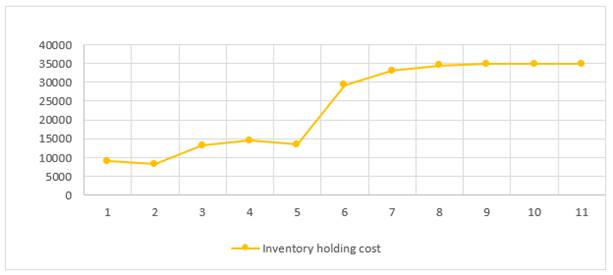
|
Figure 14 The effect
of changing the Maximum allowable deviation on the holding of inventory |
Figure 15

|
Figure
15 The effect of changing the Maximum allowable
deviation on transportation cost |
4.2. THE EFFECT OF CHANGING THE OBJECTIVES PRIORITIZATION
In this section, the effect of changing the objectives prioritization on profit, OCSL, and cost components will be studied.
Table 7
|
Table 7 Objectives prioritization |
|||
|
Objective 1 |
Objective 2 |
Objective 3 |
|
|
Order
1 (P-C-S) |
Profit |
Total
cost |
OCSL |
|
Order
2 (P-S-C) |
Profit |
OCSL |
Total
cost |
|
Order
3 (C-P-S) |
Total
cost |
Profit |
OCSL |
|
Order
4 (C-S-P) |
Total
cost |
OCSL |
Profit |
|
Order
5 (S-P-C) |
OCSL |
Profit |
Total
cost |
|
Order
6 (S-C-P) |
OCSL |
Total
cost |
Profit |
As shown in Figure 16 and Figure 17, both profit and OCSL maximum value have been achieved when giving and of them the first optimization priority as in the first, second, fifth and sixth orders because they are a non-conflicting objective.
In the third and fourth oreders while the total cost is the main objective, the profit will be decreased compared to the other four orders. In the same aforementioned orders, total revenue, material cost, manufacturing cost, non-utilized, shortage transportation cost and inventory holding cost, have been decreased compared to the other four orders as shown in Figure 18 to Figure 22.
Figure 16
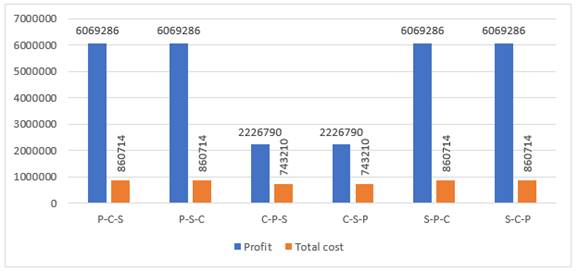
|
Figure
16 The effect of changing the
objectives prioritization on profit and total cost |
Figure 17
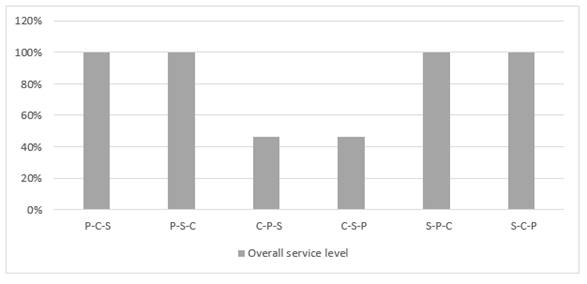
|
Figure
17 The effect of changing the
objectives prioritization on OCSL |
Figure 18
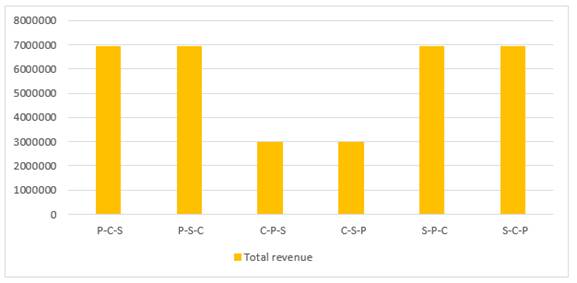
|
Figure
18 The effect of changing the objectives
prioritization on total revenue |
Figure 19
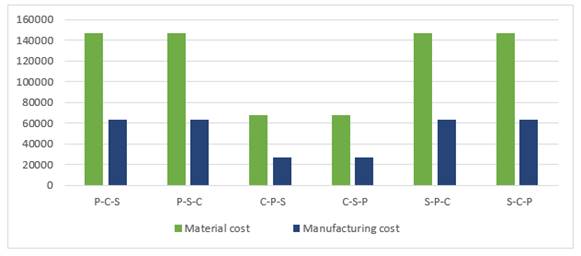
|
Figure 19 The effect
of changing the objectives prioritization on material cost and manufacturing
cost |
Figure 20
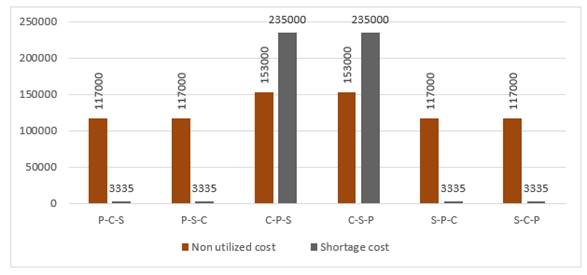
|
Figure 20 The effect
of changing the objectives prioritization on non-utilized cost and shortage
cost |
Figure 21
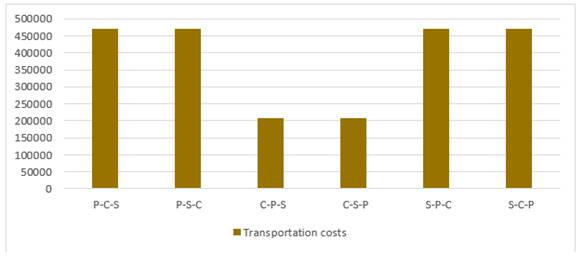
|
Figure 21 The effect of changing the objectives
prioritization on transportation cost |
Figure 22

|
Figure
22 The effect of changing the
objectives prioritization on inventory holding |
5. CONCLUSION
The developed multi-item, multi-product, and multi-period mathematical model has been successfully optimized for supply, production, distribution, and inventory planning for a multi-echelon SC of two suppliers, one factory, and two retailers, to maximize profit.
By solving and analysing the results of a thorough example, the efficiency has been demonstrated.
Supply chain performance has been investigated and analysed in terms of total revenue, cost, profit, and OCSL.
The model may be developed to:
1) Study the impact of product quality on objectives, profit, total cost, and OCSL.
2) Implement uncertainty of demand.
3) Take the suppling disruption into account.
CONFLICT OF INTERESTS
None.
ACKNOWLEDGMENTS
None.
REFERENCES
Al-Ashhab, M. S. & Alanazi, F. (2022). Developing a multi-item, multi-product, and multi-period supply chain network design and planning model for perishable products. International Journal of Research - GRANTHAALAYAH, 10(4), 179-199. https://doi.org/10.29121/granthaalayah.v10.i4.2022.4574
Al-Ashhab, M. S. & Fadag, H. (2018). Multi-Product Master Production Scheduling Optimization Modelling Using Mixed Integer Linear Programming And Genetic Algorithms. International Journal of Research-GRANTHAALAYAH, 6(5), 78-92. https://doi.org/10.29121/granthaalayah.v6.i5.2018.1429
Al-Ashhab, M. S. Afia, N. & Shihata, L. A. (2016). Objective Effect on the Performance of a Multi-Period Multi-Product Production Planning Optimization Model. International Journal of Mechanical & Mechatronics Engineering IJMME-IJENS, 16(03), 13.
Al-Ashhab, M.S. Attia, T. & Munshi, S. M. (2017). Multi-Objective Production Planning Using Lexicographic Procedure. American Journal of Operations Research, 7(03), 174. https://doi.org/10.4236/ajor.2017.73012
Al-e-hashem, S. M. J. M. & Rekik, Y. (2014). Multi-product multi-period Inventory Routing Problem with a transshipment option : A green approach. International Journal of Production Economics, 157, 80-88. https://doi.org/10.1016/j.ijpe.2013.09.005
Alashhab, M. S. & Mlybari, E. A. (2021). Developing a multi-item, multi-product, and multi-period supply chain planning optimization model. Indian Journal of Science and Technology, 14(37), 2850-2859. https://doi.org/10.17485/IJST/v14i37.867
Alashhab, M.S. & Mlybari, E. A. (2020). Developing a robust green supply chain planning optimization model considering potential risks. GEOMATE Journal, 19(73), 208-215. https://doi.org/10.21660/2020.73.52896
Altiparmak, F. Gen, M. Lin, L. & Paksoy, T. (2006). A genetic algorithm approach for multi-objective optimization of supply chain networks. Computers & Industrial Engineering, 51(1), 196-215. https://doi.org/10.1016/j.cie.2006.07.011
Aramyan, L. H. Lansink, A. G. J. M. O. Van Der Vorst, J. G. A. J. & Van Kooten, O. (2007). Performance measurement in agri‐food supply chains: a case study. Supply Chain Management : An International Journal. https://doi.org/10.1108/13598540710759826
Axsäter, S. (2015). Inventory control (225). Springer. https://doi.org/10.1007/978-3-319-15729-0
Folan, P. & Browne, J. (2005). A review of performance measurement: Towards performance management. Computers in Industry, 56(7), 663-680. https://doi.org/10.1016/j.compind.2005.03.001
Franca, R. B. Jones, E. C., Richards, C. N. & Carlson, J. P. (2010). Multi-objective stochastic supply chain modeling to evaluate tradeoffs between profit and quality. International Journal of Production Economics, 127(2), 292-299. https://doi.org/10.1016/j.ijpe.2009.09.005
Ganeshan, R. (1999). Managing supply chain inventories : A multiple retailer, one warehouse, multiple supplier model. International Journal of Production Economics, 59(1-3), 341-354. https://doi.org/10.1016/S0925-5273(98)00115-7
Guillén, G. Mele, F. D. Bagajewicz, M. J. Espuna, A. & Puigjaner, L. (2005). Multiobjective supply chain design under uncertainty. Chemical Engineering Science, 60(6), 1535-1553. https://doi.org/10.1016/j.ces.2004.10.023
Gunasekaran, A. & Kobu, B. (2007). Performance measures and metrics in logistics and supply chain management : a review of recent literature (1995-2004) for research and applications. International Journal of Production Research, 45(12), 2819-2840. https://doi.org/10.1080/00207540600806513
Hadi, S. & Parubak, B. (2016). Supply Chain Operational Capability Affecting Business Performance of Creative Industries. 2016 Global Conference on Business, Management and Entrepreneurship, 212-216. https://doi.org/10.2991/gcbme-16.2016.39
Jang, Y.-J. Jang, S.-Y. Chang, B.-M. & Park, J. (2002). A combined model of network design and production/distribution planning for a supply network. Computers & Industrial Engineering, 43(1-2), 263-281. https://doi.org/10.1016/S0360-8352(02)00074-8
Jindal, A. Sangwan, K. S. & Saxena, S. (2015). Network design and optimization for multi-product, multi-time, multi-echelon closed-loop supply chain under uncertainty. Procedia Cirp, 29, 656-661. https://doi.org/10.1016/j.procir.2015.01.024
Kotler, P. & Keller, K. L. (2016). A framework for marketing management. Pearson Boston, MA.
Mangun, N. Rombe, E. Taqwa, E. Sutomo, M. & Hadi, S. (2021). Ahp Structure For Determining Sustainable Performance Of Indonesian Seafood Supply Chain From Stakeholders Perspective. Journal of Management Information and Decision Sciences, 24(7), 1-10.
Mentzer, J. T. DeWitt, W. Keebler, J. S. Min, S., Nix, N. W. Smith, C. D. & Zacharia, Z. G. (2001). Defining supply chain management. Journal of Business Logistics, 22(2), 1-25. https://doi.org/10.1002/j.2158-1592.2001.tb00001.x
Mohamed, S. & Naji Aldosari. (2022). Modelling and Solving a Sustainable, Robust Multi-Period Supply Chain Network for Perishable Products. INDIAN JOURNAL OF ENGINEERING, 19(51), 184-195.
Morash, E. A. (2001). Supply chain strategies, capabilities, and performance. Transportation Journal, 37-54.
Muslimin, P. B. Muhammad, N. & Suryadi, H. (2017). The Impact of marketing and supply chain operational capabilities on business performance in Indonesian creative industry. International Journal of Economic Research, 14(12).
Pasandideh, S. H. R. Niaki, S. T. A. & Asadi, K. (2015). Bi-objective optimization of a multi-product multi-period three-echelon supply chain problem under uncertain environments : NSGA-II and NRGA. Information Sciences, 292, 57-74. https://doi.org/10.1016/j.ins.2014.08.068
Riswanto, A. (2021). Competitive intensity, innovation capability and dynamic marketing capabilities. Research Horizon, 1(1), 7-15. https://doi.org/10.54518/rh.1.1.2021.7-15
Rombe, E. & Hadi, S. (2022). The impact of supply chain capability and supply chain performance on marketing performance of retail sectors. Uncertain Supply Chain Management, 10(2), 593-600. https://doi.org/10.5267/j.uscm.2021.11.005
Vrat, P. (2014). Materials management. Springer Texts in Business and Economics, 978-981. https://doi.org/10.1007/978-81-322-1970-5
Wang, F., Lai, X., & Shi, N. (2011). A multi-objective optimization for green supply chain network design. Decision Support Systems, 51(2), 262-269. https://doi.org/10.1016/j.dss.2010.11.020
Yan, H. Yu, Z. & Cheng, T. C. E. (2003). A strategic model for supply chain design with logical constraints: formulation and solution. Computers & Operations Research, 30(14), 2135-2155. https://doi.org/10.1016/S0305-0548(02)00127-2
|
|
 This work is licensed under a: Creative Commons Attribution 4.0 International License
This work is licensed under a: Creative Commons Attribution 4.0 International License
© IJETMR 2014-2022. All Rights Reserved.




